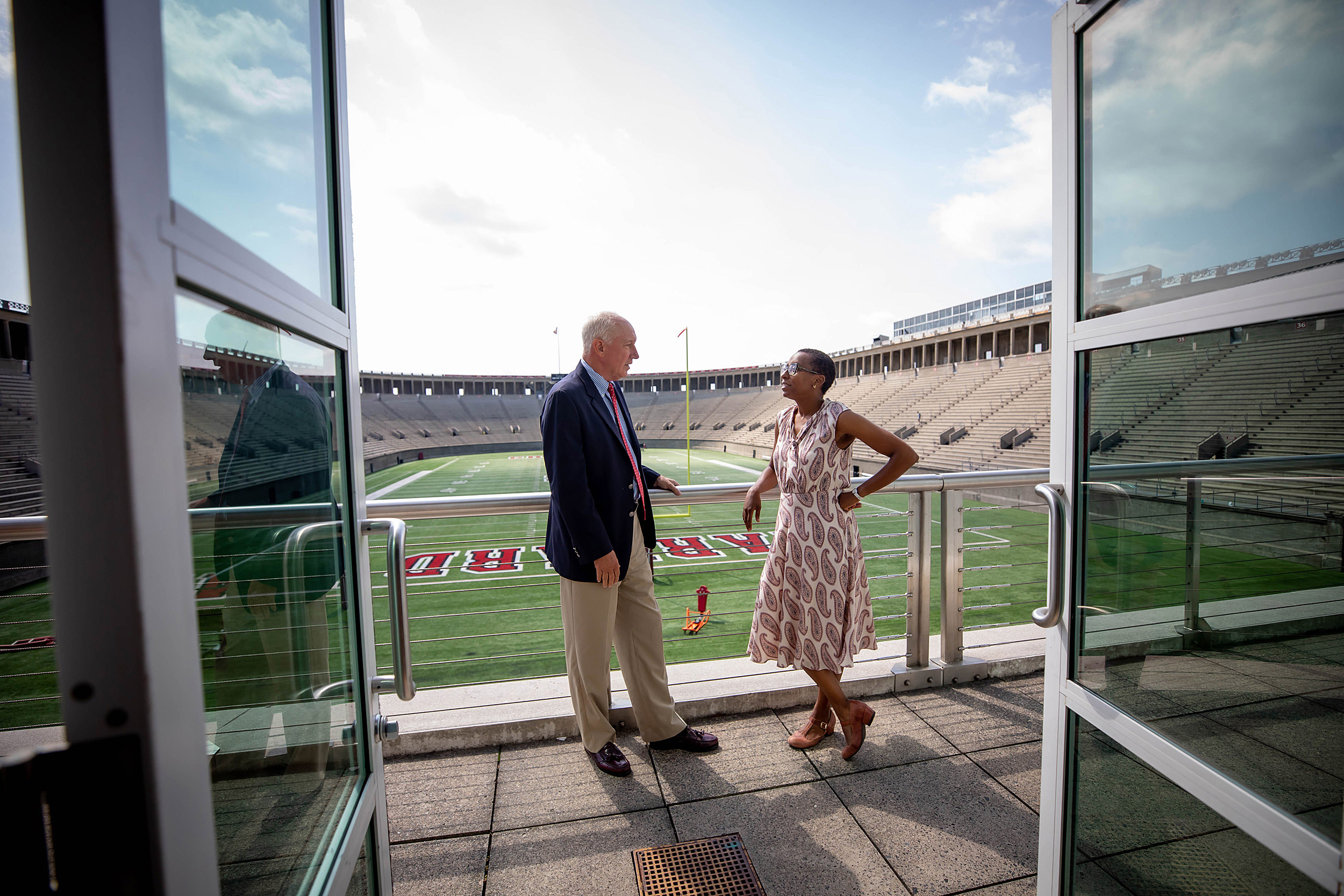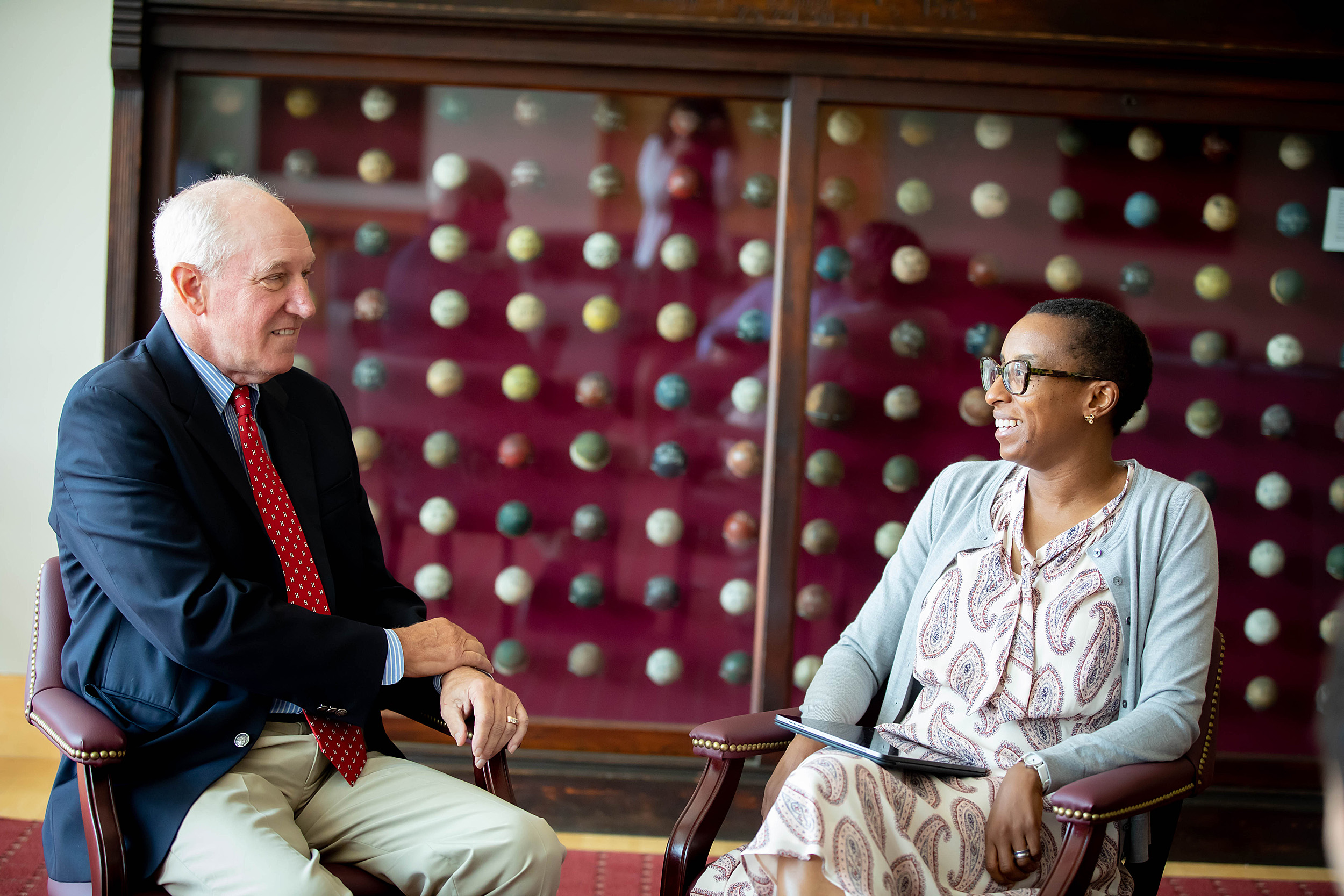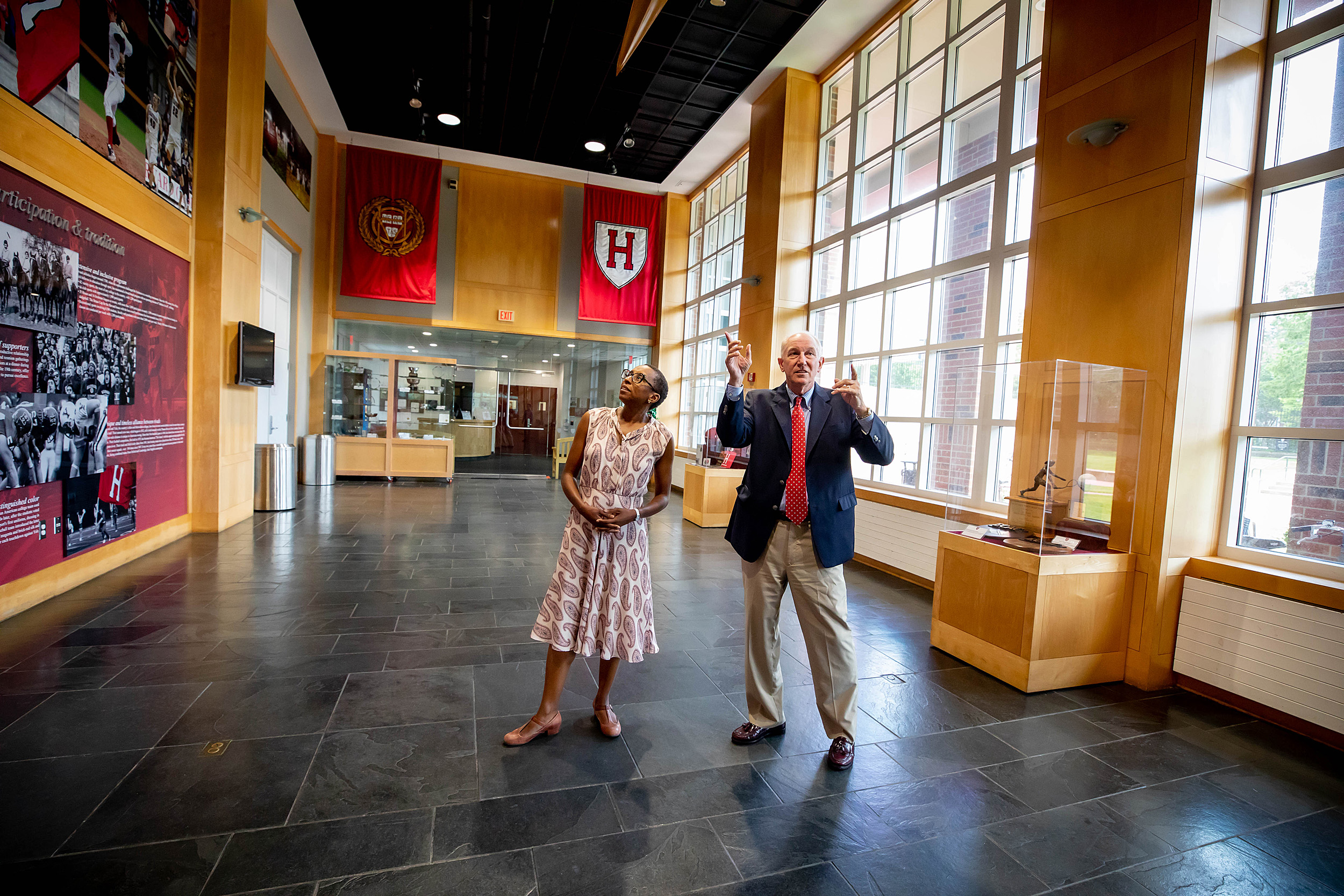
Athletics Director Bob Scalise and Dean Claudine Gay at Harvard Stadium.
Photos by Rose Lincoln/Harvard Staff Photographer
Athletics for the 21st century
New study to look at organization, programs, and student experience to lay groundwork for strategic planning
Claudine Gay, Edgerley Family Dean of the Faculty of Arts and Sciences, recently announced a study of the Department of Athletics that will examine the student-athlete experience, culture of programming, and department structure. “This important work will inform strategic planning for Harvard Athletics over the coming decade, drawing on the proud history, traditions, and the values of athletics at Harvard,” she said. The Gazette caught up with Gay and Bob Scalise, the John D. Nichols ’53 Family Director of Athletics, to learn more about the study, how the program has evolved, and the unique role that athletics plays in the lives of those on intercollegiate teams and the wider student community.
Q&A
Claudine Gay and Bob Scalise
GAZETTE: Could you tell us a little bit about the history of athletics here at Harvard, and the role it plays in the undergraduate experience?
Scalise: It actually started in the early days of Harvard College when the first-year students were challenged by the sophomores to engage in sports, so it was more like intramurals back then. Intercollegiate competition began in 1852 when Harvard faced Yale in crew. We had an invite from Yale to row on Lake Winnipesaukee in a competition, sponsored by the railroads. They wanted to get more people to use the railroads that had just been built so that was the first real competition between two colleges. I’m happy to report that Harvard won.
GAy: Good to hear.
Scalise: But for a while it wasn’t officially part of the University’s programming; it was just students at Yale and students at Harvard challenging one another. There wasn’t an athletics department or anything like that. After a while we started with some additional sports, baseball being one of them, and then what eventually became football. I think it was more like something that resembled rugby at first. A varsity club was formed, because those sports needed funding, so it was those students, their parents, and alumni that funded it, not the University.
GAy: I see, so that’s why the varsity club existed prior to the actual Athletics Department?
Scalise: Exactly. In the 1920s we finally formed a department to give it more structure. And athletics not only gave people a chance to learn things, but it was really big for community-building. Going to an Ivy League football game was the social event of the era. So back then you went not only to watch the game, but to be seen and to see other people.
GAy: I imagine during that time there wasn’t a lot of organized sports in the Boston area outside of what happened on college campuses, right?
Scalise: There were clubs, and some semi-pro entities, but the college games were certainly the main event back then. In the 1950s some of the presidents of universities got together and formed the Ivy League, and the principles were created that to this day apply to all of our sports and all of our athletic activities.
Bob Scalise and Claudine Gay discuss the future of Harvard athletics.

GAZETTE: How have athletics evolved over the years, and how is it continuing to evolve today?
Scalise: The principles of the Ivy League are really key to understanding how it has evolved. The No. 1 principle was that students who were admitted were going to be admitted by the same process and standards as every other student. Financial aid was also based on need rather than athletic ability. It was determined that academic authorities should oversee athletics, that participation in athletics should be a part of a students’ academic experience, rather than their sole reason for being here. It used to be that people would play three seasons of sports, if not four. When I was growing up, kids at my high school played football in the fall, basketball, wrestling or swimming in the winter, lacrosse or baseball or track in the spring, then tennis and softball in the summer. Now you see the adult influence in sports, and the specialization of sports, and kids choosing one sport that they focus on year-round.
GAy: I remember reading a statistic, and I’m not going to remember the source of it anymore, that said that the vast majority of athletes who are able to compete at the college level are competing in a sport that they specialized in by the age of 9.
Scalise: Wow.
GAZETTE: When do you think we started to see that change taking place?
GAy: I couldn’t pinpoint it exactly, but I think back to when I was in high school in the late ’80s, it was still possible to pick up a new sport in your freshman year, which I did.
Scalise: Right.
GAy: That was very common. Now I look at my son who just started middle school, and realistically it’s already too late to pick up something new. It’s just not even possible at this point.
Scalise: When I first started coaching here, we started the women’s soccer program, and everybody was a walk-on. All of them. Some were completely new to the sport. We were really teaching people the basics, like how to kick a ball.
GAy:Wow, what a change.
Scalise: Now everybody on the team is already an accomplished soccer player by the time they get here. When I started as the lacrosse coach in 1974, we used to also have freshmen teams. We tried to recruit people from the football team who were great athletes to play lacrosse, and some of them wound up starting for us by the time they were juniors or seniors. Those days have certainly passed.
GAZETTE: How does the mission of the College tie into athletics, and how do you see the coaches in particular supporting that mission?
GAy: One of the things I’ve been really struck by is the role of coaches as educators, especially around character-building, including resilience, how to collaborate, and certainly leadership. There are a lot of competencies that we want young people to develop over the course of their time here, and coaches put an enormous amount of time and effort into cultivating and developing those important life skills. So that is one of the obvious and powerful ways that the work of the coaches can be seen as educational at its core. It’s very complementary to what we want to do at the College.
Scalise: To add to that, from my perspective the University creates knowledge and educates leaders who will serve the world. As Dean [Rakesh] Khurana frequently articulates, the College mission is to educate the citizen leaders of the world. We believe that we educate people through athletics. It’s about building character, risk-taking, giving and receiving feedback, being a good teammate, being on time, working collaboratively with others. More recently we’ve prioritized integrating the aspects of diversity and inclusion. It’s so wonderful that we have people from all different backgrounds, different races and religions, political views, sexual orientations, all on the same team working together to achieve a common purpose. This is a really important part of an education for our young people. It’s part of what we do when we bring everyone together as part of the residential community at Harvard. We expect them to work together, and learn from one another. And athletics is one of the vehicles where they can do that.
GAy: That’s what I mean when I say that athletics is one of the sites where the Harvard College mission is lived and expressed.
Scalise: We in athletics talk about it not as extracurricular, but actually as co-curricular. We believe it is actually a part of the overall educational experience that we want our students to experience.

GAZETTE: Could you tell us a little bit about the study that was announced recently, and what you hope to achieve with it?
GAy: Well, the department’s centennial anniversary is rapidly approaching. This study is our opportunity to set our aspirations for the next century, and do so in a way that builds on the successes we have achieved over the last almost 100 years and that maintains our position as a standard-bearer among our peers in the Ivy League. The question is: How do we continue to do that in a context that has changed dramatically since the department’s founding, or even since the establishment of the Ivy League? We were just talking about the change in terms of the professionalization and the specialization of youth sports as one example. But more generally we have a new generation of students on our campus, so how do we reinvigorate our core commitments and principles so that they feel relevant to the students who are here now?
Scalise: I’m excited that we’re doing this study, because it will give us a roadmap in terms of where we want to go moving forward, and also tell us what things we might want to emphasize more in athletics. But I also think we will see that we are doing some really positive things here. And one of the challenges is figuring out how we can create that experience for more of our students. So I think there will be some good that comes from this for others, as well as for our department. There’s a real bond that is created with our students and their coaches. And whenever one of our alumni comes back, one of the first things they do is stop by to see their coach. We would love them to stop to see not only their coach, but also a key adviser or faculty member, or maybe someone they got to know in the administration. That would be ideal. So, we want to better understand what we are doing here at athletics that creates these bonds, and how can we do that all over Harvard?
GAy: I absolutely agree. One of the hopes is to take what we learn from this study and use it for the benefit of all of our students. For example, there is the strong sense of belonging that is so evident in the student-athlete community, the pride in the institution, much of it forged through their involvement in athletics. That feeling of being “at home at Harvard,” that is something we want for every student. How might we cultivate that for all of our students?
GAZETTE: In the announcement you talked about engaging the Harvard community. Can you tell us more specifically who, and what groups you want to hear from as part of this process?
GAy: Everybody! First and foremost the students. I’m eager to hear more about their experience. Also, the coaches, athletics staff, faculty, and other campus partners to the department. We hope to connect with alums whose participation in athletics during their time at the College remains a source of continuing attachment and love for Harvard.
Scalise: One of the things I’m hoping to get out of this is to make sure we have the right balance between this strong bond and affiliation with their team, and also taking advantage of the rest of what Harvard has to offer. I really want this study to include people who are not athletes. In a lot of the sports programs around the country, you see all these specialized programs just for student-athletes. And so of course the athletes all hang together.
GAy: Yes, a world apart.
Scalise: Right. It’s not the approach we want to take. So how do we make sure that the student-athlete experience is similar to other students’ experiences, and that they intersect? How do we orchestrate the right balance there so that people can connect with one another?
GAZETTE: So while athletics is obviously the focus of this study, it sounds like the goal is to have it ultimately touch on other facets of the University.
GAy: Exactly. When we think about the student-athlete experience, at its foundation we want it to be integrated, academically and socially, and broadly similar to the experience of non-athletes. We want every student to take full advantage of everything Harvard has to offer.
Scalise: I’m also hoping that this will not just be about intercollegiate athletics, but also look at our club offerings and our intramurals. And a big thing on my mind right now is overall health and wellness for our students. Are we doing everything we can do to ensure the health and wellness, both physically and mentally, of these young people we are about to send off into the world? So, there are a lot of different parts to this study.
GAZETTE: What can you tell us about the timing of the study?
GAy: Because we want this effort to benefit from extensive outreach and consultation, the work is going to take a while. We hope by early spring the study will be complete and that we will be able to share a public report with the community.
Scalise: Claudine has been dean for just about a year now, and over that time we have had extensive conversations where we’ve tried to make her aware of a broad range of athletics issues.
GAy: Yes, and that groundwork was critical because it helped me to frame what the questions are that we want to answer. Being able to approach this with the benefit of some contextual knowledge has been really helpful. I’ve spent a lot of time on that in the last year. One thing I also want to emphasize about the study is that we not only want to engage in broad outreach, we want people to participate. And we want them to participate in an open and candid way so that what we learn from the study has real credibility. Good participation is something that will be really critical to the success of the whole effort. Many colleges and universities seem to be undertaking some sort of study or review of athletics, and a lot of it feels very reactive. That’s not what we’re engaged in here. This is about using this moment to think about what the future could look like for Harvard Athletics, and challenging ourselves to be really intentional about it.



